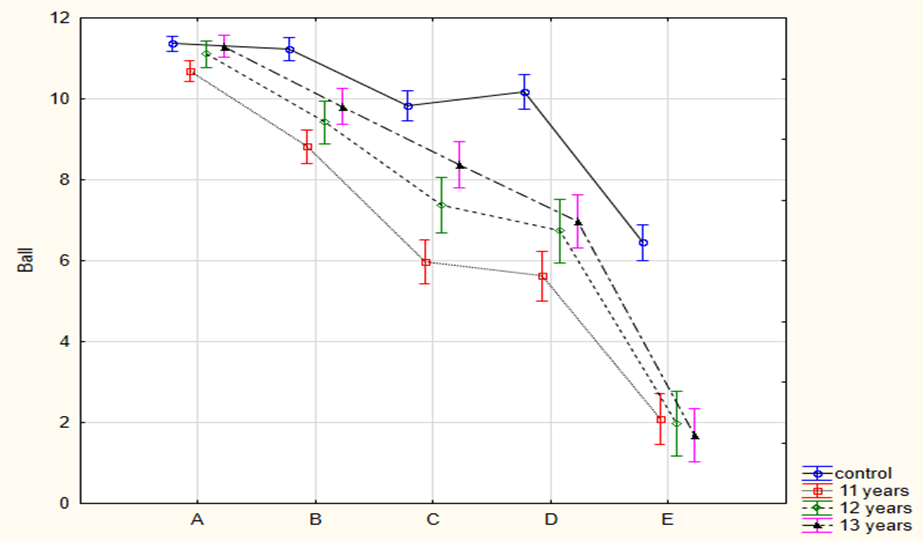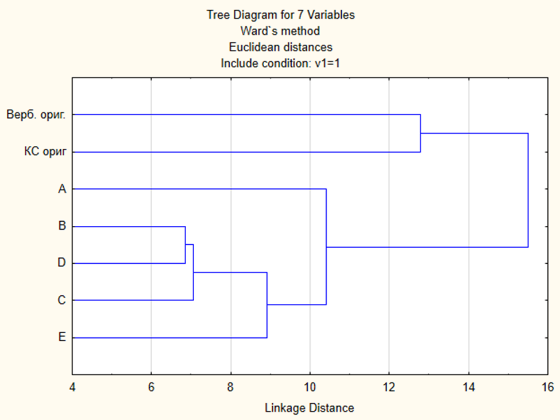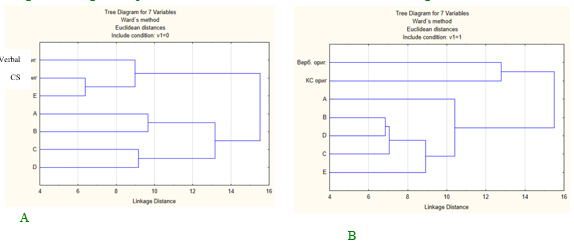Abstract
Creativity is a complicated process that conceals a huge amount of unclear mechanisms which are the prospect to be revealed. At current well-known that the creation process requires the development of a wide range of cognitive functions. There is no consensus about age-related patterns of development of verbal creativity. In the scientific literature, there are contradictory data available supporting its linear or non-linear erratic growth, as well as lack of distinction in the level of verbal creativity at any age. At current, the speed of evolvement of cognitive attitudes and the mechanism of interaction between the accumulated knowledge, the semantic structure, and the method of solving the problem are still unclear. The research question is how the rate of age-related development of critical related to the formation of the semantic space for the flexible search for an original solution to the problem. The aim of this study was to find out the age-related features of the relationship between verbal creativity and fluid intelligence. The revealed age-related differences in the indicators of creativity and IQ and features of their relationship allow us to conclude that the speed of mental processes, executive control of choosing the best solution is not yet sufficiently developed in students aged 11-13.
Keywords: Age, creativity, cognitive flexibility, intelligence
Introduction
The process of creation is a complex phenomenon that requires the development of a wide range of cognitive functions. It is a necessary condition for the establishment of creative thinking or producing original ideas and choosing unusual responses in case of psychometric studying of creativity. The environmental features, such as the peculiarity of education at each stage of age development, can improve or impede creative thinking development.
For instance, some researches shows that peoples with dyslexia demonstrate a higher rate of creative abilities (Cancer et al., 2016; Kapoula et al., 2016). Presumably, it is possible in consequence of disruption in the synchronization of bioelectrical activity in various brain areas. For example, Finn et al. (2014) reports that the desynchronization in brain areas responsible for processing of visual and audio information when reading increase the probability of producing remote verbal and image associations. The functional interaction of specialized areas of the neocortex is being formed in a development (and learning) process during various stages of which the dominance of phonetic-related neuronal networks switches to the semantic related networks and the visual perception related networks (Zhou et al., 2021).
The widespread language network includes: front-medial and parieto-medial regions of cortex for processing coherence; posterior middle temporal gyrus, anterior temporal lobe, medial prefrontal, and dorsomedial prefrontal cortex for inference process; and the dorsolateral prefrontal cortex for executive functions.
Some researchers confirm correlations between age development and verbal abilities during early ontogenesis as well as at the schooling age (Cuevas & Bell, 2014; Hughes et al., 2010).
There is another marker of successful learning in the 4 — 13 age range known as cognitive flexibility. This index is a specialized component of executive control (Buttelmann & Karbach, 2017; Yeniad et al., 2013).
There is no consensus about age-related patterns of development of verbal creativity. In the scientific literature, there are contradictory data available supporting its linear or non-linear erratic growth, as well as lack of distinction in the level of verbal creativity at any age (e.g., Kleibeuker et al., 2013). That uncertainty (ambiguity) in the process of creativity formation can be explained by the uneven development of all components of verbal functions (Conti-Ramsden et al., 2012) and creative thinking in children. As a result, we have ambiguous cumulative psychometric results in studies of creativity.
Problem Statement
Apparently, the age-independent basis of creativity is the ability to resist the ideas occurring first and shift one’s behaviour to search for different cognitive strategies. According to a report by German and Defeyter (2000), functional fixedness emerges already in children 6-7 years old and it impedes their solving of object-use problems.
However, at current the speed of evolvement of cognitive attitudes and the mechanism of interaction between the accumulated knowledge, the semantic structure and the method of solving the problem are still unclear.
The study of age-related features of the relationship between creativity and intelligence revealed the appearance of their relationship in children of 11-12 years old, but not in first-graders (Nikolaeva & Novikova, 2014). A recent study shows that such variables as age, intelligence, and creativity can explain 7-12% of the inconstancy in the study results for pupils in 11-13 year age range. The observed decrease in the creativity indicators of 13-year-olds compared to 11-year-olds is presumably due to the formation of critical thinking and/or acquired learning skills that hinder effective cognitive activity in the new conditions for evaluating its effectiveness (Razumnikova & Nikolaeva, 2019).
Research Questions
To be able to produce new semantic categories requires knowledge and the skill to use it flexibly. According to the dual model of creativity, it is based on such fundamental cognitive processes as working memory and information selection management (Nijstad et al., 2010; Sowden et al., 2014). There is evidence that verbal creativity is associated with working memory capacity and vocabulary as a component of crystallized intelligence (Chuderski & Jastrzębski, 2018; Salvi et al., 2016). Moreover, mental vocabulary is determined by the functions of the semantic network, where searching for associations depends on such psycholinguistic variables as contextual diversity, concreteness or centrality of words in pairs of associations (Mak & Twitchell, 2020). However, the question remains: how the rate of age-related development of critical (i.e. convergent thinking) related to the formation of the semantic space for the flexible search for an original solution to the problem (i.e. divergent thinking).
The most cited opinion in the scientific literature showing that the development of nerve fibres of the left frontal-occipital and lower longitudinal tracts is completed by the age of 18. It has been shown that the development of these structures positively correlates with the ability to find remote associations and plays an important role in linguistic functions and concept formation (Takeuchi et al., 2020). Based on these data, it can be assumed that the maturation of the left frontal-occipital and inferior longitudinal fascicles can provide a more efficient search for an original idea when testing verbal creativity.
Purpose of the Study
The aim of this study was to find out the age-related features of the relationship between verbal creativity and fluid intelligence, which reflects the ability to learn and flexibility of thinking, which determines the effectiveness of switching strategies when performing different tasks.
Research Methods
Participants
The study involved 155 secondary school students aged 11-13 and 168 1st-year university students aged 18-21 years. The study conformed to the principles of the Declaration of Helsinki and was approved by the Ethical Committee of the Faculty of Humanities, Novosibirsk State Technical University. All participants, i.e. university students and parents of children signed a written informed consent form after the procedures were thoroughly explained.
Measures
For evaluation of verbal creativity, was used: 1. J.P. Guildford's "Alternative uses test" (AUT) (time limit = 5 min.); 2. the task of our own design — "cognitive synthesis task", requiring from subjects to contrive few sentences using three given semantically remote words from different semantic categories (CS) (time limit = 15-20 minutes.). For intelligence evaluation, Raven's standard progressive matriceswere used (time limit = 20 minutes). The students' recorded their answers into ready blank forms.
To quantify the indicators of the originality of ideas when performing AUT, a previously developed computerized method was used, according to which originality was calculated as the reciprocal of the number of the same ideas according to a previously created database (Razumnikova & Nikolaeva, 2019). The originality of the sentences (CS test) was determined on the basis of an expert assessment according to the system 0 — stereotyped idea, 2 — original, 1 — intermediate result. For example, the sentence “the clock on the chain fell into the fire” was evaluated at 0 points, “the clock ticked, I drew fire, and the chain forgotten by my father lay on the table” at 1 point, and “The fire of hope did not subside and fed the hours of reflection of the prisoner shackled with chain” — 2 points.
For statistical analysis, were used indicators of verbal originality, number of correct answers in each of the Raven's test series and age-standardized IQ.
Findings
Age-associated effects in verbal creativity and IQ scales
ANOVAs of the verbal originality indicators were performed with the age variable (2: students and schoolchildren). According to the obtained effect, students were characterized by higher values of verbal creativity compared to schoolchildren: 2.04 ± 0.12 and 0.84 ± 0.12, respectively (F1.254 = 55.27, p = 0.00000, η2 = 0.18) when testing AUT and 3.70 ± 0.28 and 0.95 ± 0.30 , respectively (F1.254 = 44.56, p = 0.00000, η2 = 0.19) when testing the CS. Figure 1 shows the results of intelligence testing for each subtest in different age groups (the control group was made up of university students). Intergroup comparison indicates a lower IQ level in schoolchildren compared to students: 94.95 ± 0.89 and 110.25 ± 0.99, respectively (F1.254 = 131.48, p = 0.00000, η2 = 0.32). Schoolchildren of different ages do not differ significantly among themselves on individual scales and as well as students perform only subtest A. The advantage of students in subtests D and E is especially great (Figure 1).
The improvement in the performance of both intellectual and creative tasks in young people in comparison with schoolchildren can be explained by the discovered age-related changes in functional connectivity in the Default Mode Network (DMN) in the anterior brain system: what they were the younger, the stronger the FC was and the slower they performed the tasks (Jiang et al., 2018). Namely, a particularly low efficiency of completing tasks in series D and E was due to the fact that many children did not have time to complete them within 20 minutes (see Figure 1). And it was also slower for children to come up with answers when testing creativity. The observed increase in verbal originality with age is consistent with the results of another study of verbal divergent thinking (Kleibeuker et al., 2013) and the ideas about the dynamics of the development of executive control of behaviour and exploratory behaviour (Razumnikova & Nikolaeva, 2019). Since lower values of verbal originality at 11-13 years old were found when using different methods: AUT and CS, it can be concluded that at this age, compared with the age of 18-21 years, such basic components of creativity as convergent critical thinking allowing to choose the most original answer (in the situation of the AUT), and effective divergent thinking, necessary for the search for distant associations to the given words-stimuli (in the situation of the CS) are still insufficiently formed.

Age-related effects in association between verbal creativity and IQ scales
To find out age-related patterns in the organization of verbal creativity, we performed a hierarchical cluster analysis of the indicators of originality and effectiveness of individual Raven subtests. The obtained dendrograms for the group of schoolchildren (A) and students (B) are shown in Fig.2. They indicate the formation of 2 clusters in both groups, but of a different organization. For schoolchildren, the originality of the compiled sentences forms a cluster together with the performance indicator of the subtest E, the success which is determined by the understanding of the synthesis principle and the speed of analysis of the presented figures (Figure 2A). In students, the indicators of verbal originality are represented by one cluster, which is associated with another, representing different components of IQ with the combination of speed and analytical abilities of information processing (Figure 2B).
According to the results of the correlation analysis, only students are characterized by a significant relationship of originality indicators according to the two methods used for assessing verbal creativity (r = 0.37, p = 0.008), as well as their relationship with IQ (r = 0.42, p = 0.0001 for AUT and r = 0.22, p = 0.03 for CS). No such connection was found among schoolchildren. Consequently, the data obtained indicate that they still have insufficient integration in the organization of the interconnection of convergent and divergent thinking in comparison with students for an effective search for an original idea.


Conclusion
The originality of verbal thinking in schoolchildren aged 11-13 is less than in young adulthood aged 18-21. According to the results of Raven’s B-E tests series, reduced level of verbal originality is accompanied by a lower level of convergent thinking. The revealed age-related differences in the indicators of creativity and IQ and features of their relationship allow us to conclude that the speed of mental processes, executive control of choosing the best solution is not yet sufficiently developed in students aged 11-13. Also, the semantic space that allows for fast search for the most original semantic connections of words has not yet been formed as well.
Acknowledgments
This study was supported by the Russian Foundation for Basic Research, project no.19-29-01017
References
Buttelmann, F., & Karbach, J. (2017). Development and plasticity of cognitive flexibility in early and middle childhood. Frontiers in Psychology, 20(8), 1040.
Cancer, A., Manzoli S., & Antonietti, A. (2016). The alleged link between creativity and dyslexia: Identifying the specific process in which dyslexic students excel. Cogent Psychology, 3.
Chuderski, A., & Jastrzębski, J. (2018). Much ado about aha!: insight problem solving is strongly related to working memory capacity and reasoning ability. Journal of Experimental Psychology: General, 147, 257–281.
Conti-Ramsden, G., St Clair, M. C., Pickles, A., & Durkin, K. (2012). Developmental trajectories of verbal and nonverbal skills in individuals with a history of specific language impairment: from childhood to adolescence. Journal of Speech, Language, and Hearing Research (JSLHR), 55(6), 1716-35.
Cuevas, K., & Bell, M. A. (2014). Infant attention and early childhood executive function. Child Development, 85, 397–404.
Finn, E. S., Shen, X., Holahan, J. M., Scheinost, D., Lacadie, C., Papademetris, X., Shaywitz, S. E., Shaywitz, B. A., & Constable, R. T. (2014). Disruption of functional networks in dyslexia: a whole-brain, data-driven analysis of connectivity. Biological Psychiatry, 1, 76(5), 397-404.
German, T. P., & Defeyter, M. A. (2000). Immunity to functional fixedness in young children. Psychonomic Bulletin & Review, 7, 707-712.
Hughes, C., Ensor, R., Wilson, A., & Graham, A. (2010). Tracking executive function across the transition to school: a latent variable approach. Developmental Neuropsychology, 35(1), 20-36
Jiang, P., Vuontela, V., Tokariev, M., Lin, H., Aronen, E. T., Ma, Y., & Carlson, S. (2018). Functional connectivity of intrinsic cognitive networks during resting state and task performance in preadolescent children. PLoS One, 17, 13(10).
Kapoula, Z., Ruiz, S., Spector, L., Mocorovi, M., Gaertner, C., Quilici, C., & Vernet, M. (2016). Education influences creativity in dyslexic and non-dyslexic children and teenagers. Plos One, 11(3), 1-14.
Kleibeuker, S. W., De Dreu, C. K., & Crone, E. A. (2013). The development of creative cognition across adolescence: distinct trajectories for insight and divergent thinking. Developmental Science, 16(1), 2-12.
Mak, M. H. C., & Twitchell, H. (2020). Evidence for preferential attachment: Words that are more well connected in semantic networks are better at acquiring new links in paired-associate learning. Psychonomic Bulletin & Review, 27(5), 1059-1069.
Nijstad, B. A., DeDreu, C. K. W., Rietzschel, E. F., & Baas, M. (2010). The dual pathway to creativity model: creative ideation as a function of flexibility and persistence. European Review of Social Psychology, 21, 34–77.
Nikolaeva, E. I., & Novikova, A. V. (2014). Comparative analysis of intelligence and creativity with parameters of simple and complex sensorimotor reactions in younger adolescents. Actual problems of psychological knowledge, 32, 47-52.
Razumnikova, O. M., & Nikolaeva, E. I. (2019). Inhibitory Brain Functions and Age-Associated Specificities in Organization of Cognitive Activity. Uspekhi fiziologicheskikh nauk, 50(1), 75–89.
Salvi, C., Bricolo, E., Kounios, J., Bowden, E., & Beeman, M. (2016). Insight solutions are correct more often than analytic solutions. Think Reason, 22, 443–460.
Sowden, P. T., Pringle, A., & Gabora, L. (2014). The shifting and creative thinking: connections to dual-process theory. Think Reason, 0, 1–21.
Takeuchi, H., Taki, Y., Matsudaira, I., Ikeda, S., Dos, S., Kawata, K. H., Nouchi, R., Sakaki, K., Nakagawa, S., Nozawa, T., Yokota, S., Araki, T., Hanawa, S., Ishibashi, R., Yamazaki, S., & Kawashima, R. (2020). Convergent creative thinking performance is associated with white matter structures: Evidence from a large sample study. Neuroimage, 15, 210.
Yeniad, N., Malda, M., Mesman, J., van Ijzendoorn, M. H., & Pieper, S. (2013). Shifting ability predicts math and reading performance in children: a meta-analytical study. Learning and Individual Differences, 23, 1–9.
Zhou, W., Cui, X., Shi, B., Su, M., & Cao, M. (2021). The development of brain functional connectome during text reading. Developmental cognitive neuroscience, 48.
Copyright information

This work is licensed under a Creative Commons Attribution-NonCommercial-NoDerivatives 4.0 International License.
About this article
Publication Date
02 December 2021
Article Doi
eBook ISBN
978-1-80296-117-1
Publisher
European Publisher
Volume
118
Print ISBN (optional)
-
Edition Number
1st Edition
Pages
1-954
Subjects
Linguistics, cognitive linguistics, education technology, linguistic conceptology, translation
Cite this article as:
Razumnikova, O., & Kagan, V. (2021). Age-Associated Developmental Trajectories For Verbal Divergent Thinking. In O. Kolmakova, O. Boginskaya, & S. Grichin (Eds.), Language and Technology in the Interdisciplinary Paradigm, vol 118. European Proceedings of Social and Behavioural Sciences (pp. 384-390). European Publisher. https://doi.org/10.15405/epsbs.2021.12.48

